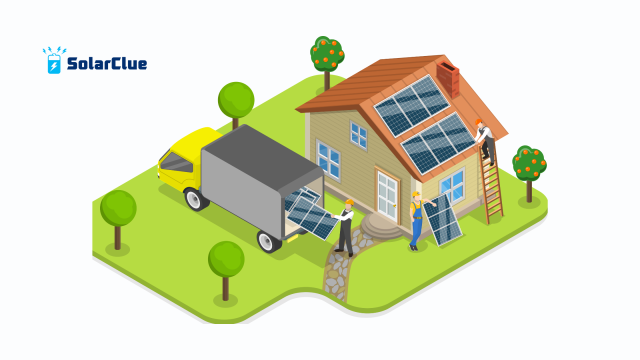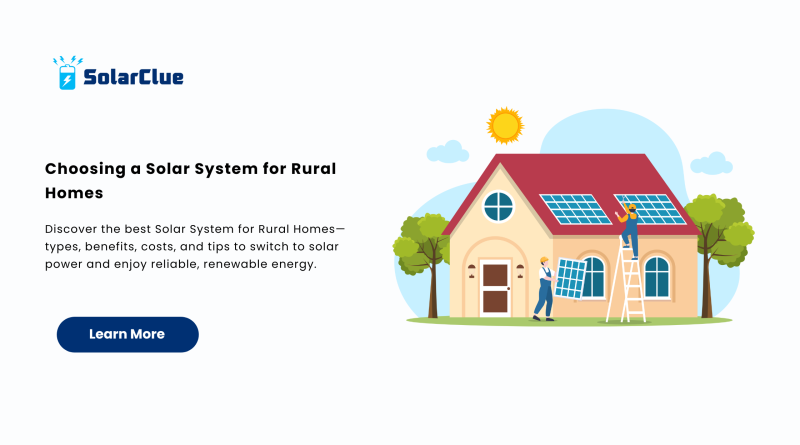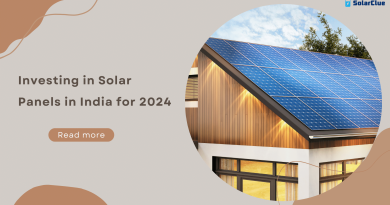Choosing a Solar System for Rural Homes
Access to electricity should be a basic right—not a luxury. For families in remote areas, a Solar System for Rural Homes offers a powerful and sustainable solution to this everyday challenge.
Table of Contents
- 1 Why Rural Homes Need Solar Power
- 2 Benefits of Using a Solar System in Rural Areas
- 3 Types of Solar Systems for Rural Use
- 4 Key Components of a Solar System
- 5 How to Choose the Right Solar System
- 6 Installation Process Made Simple
- 7 Cost of Installing a Solar System in Rural Homes
- 8 Government Subsidies and Incentives
- 9 Maintenance of Solar Systems
- 10 Myths About Solar Energy Debunked
- 11 Environmental Impact of Solar Power
- 12 Long-Term Savings and Returns
- 13 Common Challenges in Rural Solar Adoption
- 14 How to Get Started
- 15 Conclusion
- 16 FAQs
Why Rural Homes Need Solar Power
In many rural areas, electricity supply is often inconsistent or unavailable. For families living in such places, having a Solar System for Rural Homes offers a practical and reliable energy solution. These homes often receive ample sunlight, making it ideal for harnessing solar energy to generate power for daily needs. Whether it’s lighting, charging devices, or running small appliances, solar power ensures you’re never left in the dark.
Benefits of Using a Solar System in Rural Areas
Installing a solar system in rural homes comes with many advantages. First, it provides energy independence, meaning you won’t have to rely on unpredictable electricity grids. Second, it drastically reduces electricity bills, helping families save money over time. Additionally, it’s a clean and green form of renewable energy, which means it doesn’t harm the environment. And lastly, with growing government subsidies and support, installing a solar power system is more affordable than ever before.
Types of Solar Systems for Rural Use
There are three major types of solar systems suitable for rural households:
-
Off-Grid Solar System: Ideal for remote locations with no electricity access. These include solar panels, batteries, and inverters, providing a fully independent energy setup.
-
On-Grid Solar System: This system connects to the power grid and allows excess energy to be fed back into the system, earning credit on future bills.
-
Hybrid Solar System: A combination of on-grid and off-grid, offering flexibility to store power and use grid energy when necessary.
Each of these solar power systems serves different needs, so choosing the right one depends on your power requirements and location.
Key Components of a Solar System
A solar system typically includes:
-
Solar panels to capture sunlight and convert it into electricity.
-
An inverter to convert direct current (DC) into alternating current (AC) for household use.
-
Batteries to store energy for use at night or during cloudy days.
-
Charge controllers to manage power flow and prevent battery overcharging.
These components work together to provide seamless, reliable electricity to your home.
How to Choose the Right Solar System

Before choosing a Solar System for Rural Homes, assess your daily energy usage. Calculate the wattage of all the appliances you use and how long they run each day. Next, determine your budget. While initial costs can vary, the long-term savings make it worth the investment. Finally, consider the sunlight availability in your area. If your region has consistent sunlight, you’ll benefit more from solar energy systems.
Installation Process Made Simple
Installing a solar system involves several steps—starting with a site survey to check sunlight availability and roof space. After that, a system is designed based on your needs. Certified professionals then install the solar panels, connect wiring, mount the inverter, and complete safety checks before activation.
Cost of Installing a Solar System in Rural Homes
The price of a solar power system in rural areas can range from ₹75,000 to ₹3,00,000 depending on size and type. However, government incentives can bring this cost down considerably, making it accessible even for low-income households. Keep in mind that these systems last up to 25 years, offering substantial long-term savings.
Government Subsidies and Incentives
In India, the Ministry of New and Renewable Energy (MNRE) provides up to 40% subsidy on residential rooftop solar systems. Additionally, many states offer their own incentives, making it even more affordable to make the switch to solar power. These schemes are especially beneficial for rural families looking to invest in clean energy solutions.
Maintenance of Solar Systems
Once installed, solar systems require minimal maintenance. Regularly clean the solar panels to ensure maximum sunlight absorption. If you have lead-acid batteries, check their water levels every few months. Annual inspections from your service provider can help keep the system efficient and identify any issues early.
Myths About Solar Energy Debunked
Many people hesitate to install solar systems because of common myths. Some believe they don’t work in cloudy weather—but solar power systems are effective even on overcast days. Others think they’re too expensive, but costs have dropped dramatically in recent years. Lastly, many assume solar panels need constant replacement, but they can last 25 years or more with minimal upkeep.
Environmental Impact of Solar Power
Switching to solar energy reduces dependency on fossil fuels, which are harmful to the environment. Solar electricity generates no air pollution, no water pollution, and no greenhouse gases. By installing a solar power system, you’re contributing to a healthier, cleaner planet for future generations.
Long-Term Savings and Returns
While the upfront cost of a solar system may seem high, the return on investment is substantial. Most homeowners recover their initial investment within 3 to 5 years through reduced power bills and government benefits. Over the lifetime of the system, you can save lakhs of rupees.
Common Challenges in Rural Solar Adoption
Some of the hurdles faced in rural areas include lack of awareness, high initial costs, and limited access to skilled technicians. Fortunately, awareness campaigns and affordable government schemes are helping to overcome these barriers, making solar energy a practical choice for more families.
How to Get Started
If you’re ready to install a Solar System for Rural Homes, begin with a professional energy audit to assess your needs. Choose a trusted provider to design and install your system. Apply for available government subsidies to reduce your costs. And most importantly, stay informed—check out reliable platforms to learn more.
Conclusion
Investing in a Solar System for Rural Homes is a smart and sustainable choice. It offers reliable power, long-term savings, and a cleaner environment. Whether you’re dealing with frequent power cuts or simply want to cut down your electricity bills, switching to solar is the future. Take control of your energy needs today and enjoy peace of mind with the power of the sun. For trusted solutions and detailed insights, head over to solarclue.com and explore more tips at blog.solarclue.com.
FAQs
1. How much does a solar system for a rural home cost?
It typically ranges between ₹75,000 to ₹3,00,000 depending on size and type.
2. What is the best solar system for rural homes?
Off-grid or hybrid systems are usually best due to grid unreliability in rural areas.
3. Are government subsidies available for solar in rural India?
Yes, the MNRE offers up to 40% subsidies, plus additional state-level benefits.
4. How long does a solar panel last?
Most solar panels last over 25 years with basic maintenance.
5. Can I install a solar system myself?
It’s best to hire certified professionals to ensure safety, compliance, and optimal performance.




